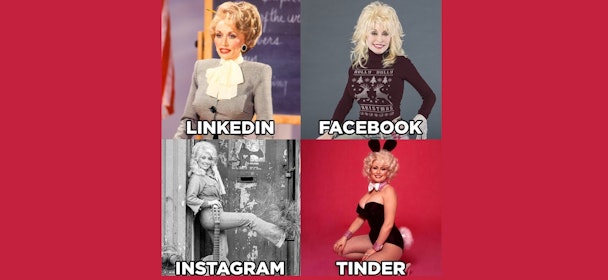Do we need new audience segmentations for the metaverse?
How will marketeers develop segmentations, personas and insight in the metaverse? Fran Docx, strategy partner, 20something, explores the complex challenge.

Dolly Parton knows the importance of audience segmentation
I want to start this inquiry into the future of our digital identity where all good inquiries should start – with Dolly Parton. The year is 2020 BC (Before Covid), and Dolly Parton has just celebrated her 74th birthday. In a quiet moment after the festivities subside, Dolly is sitting at her laptop with a wry smile on her face, struck by an amusing notion. She begins, slowly, to paste together four different pictures of herself in a 2x2 grid. The top left shows her looking studious with big hair in front of a blackboard, and underneath she writes ‘LINKEDIN.’ Next, she places another picture of herself, this time front to camera wearing a ‘Holly Dolly Christmas’ festive jumper and a broad grin that says, “pop round anytime, I’ve just made brownies.” Under this picture she writes ‘FACEBOOK.’
On a roll now, Dolly bashes out the last two pictures. Bottom left is a black-and-white shot of her with her guitar, power-posing – an exquisite foil to the beaten-up doorway she rests against. Half album cover, half fashion shoot, this is ‘INSTAGRAM.’ The final picture, obviously, is Dolly in a Playboy Bunny outfit with ‘TINDER’ – this one perhaps not quite as nuanced as the others, but Dolly feels she has made her point.
To this day, I don’t believe Dolly Parton has a Linkedin or a Tinder profile, and yet her observation is an astute one. We have created different codes for different virtual spaces.
And in turn, those spaces have codified these through actual code, as the user interface (UI) and user experience (UX) enhances the identity we are trying to build. Instagram filters beautify, its virtual backdrops placing us in exotic and interesting environments. Its tagging feature enables us to namecheck not only people but shops, designers and products. Note that Dolly’s Instagram picture is the only one with a prominent ‘prop’ in it.
In a complex collapsing of cause and effect, we extrapolate that gen Z are about goofing around, making relatable comedy because they’re on TikTok, whereas millennials are superficial and image-obsessed because they use Instagram.
In some superficial ways we have already started marketing to our virtual selves. Every time you see the words ‘make it instagrammable’ or ‘how-tos work well on TikTok,’ we are keeping those digital identities, and what they value, in mind. We are also keeping the algorithms in mind, but to unpick the unholy alliance between our virtual identities and the algorithms that shape them is best left for another day.
The promise of the metaverse, depending on which billionaire tech chief exec you ask, is a centralized identity, a ‘virtual self’ that can move seamlessly through different community and commercial spaces in the digital world. This new web experience will see an uncoupling of our digital selves from the social platforms that have shaped them. And rather than our current, split, personalities, we will have one (coherent?) virtual self.
Whether for status or survival, this digital self, like our real-world selves and our social platform selves (web2 selves?), will seek to define its identity.
But how, with what means? And more importantly, how will marketeers reverse engineer this process to develop segmentations, personas and insight?
In my mind there are three clear signals that could already form the basis of our new segmentations.
-
Digital product ownership (and extent of use)
-
Transaction history
-
Avatar behavioral analysis
The first one is obvious – what are people buying and displaying digitally? Whether that’s clothing, real estate, music, avatars or art. In the same way that we currently recognize a person who buys an Aston Martin is not the same person who buys a Ferrari, we will segment based on the signals from the products people buy. We will also have a decent understanding of the cost of these digital products and may be able to work out your ‘digital net worth’ as a further targeting demographic.
The next signal for segmentation is transaction history. This one’s a bit scary.
Much like dogs and tattoos, blockchain transactions are for life. When you buy and sell through blockchain technology, the record of that action is indelible. Consequently, our transaction history and crypto wallet become our digital reputation. Those Squid tokens you bought back in 2021 could haunt you forever as a signal of your gullibility or susceptibility to hype. In the wrong hands, this information could be dangerous.
And finally, avatar behavioral analysis – sort of what it says on the tin.
How does your avatar interact with others? What are your digital behaviors and habits? A study recently found a link between avatar behavior and stature with real-life behavior. That is, when an avatar was made to appear taller or better-looking in a digital space, the real-world owner of the avatar was said to behave with more confidence and assertion in their offline lives too.
To conclude with our opening question, do we need new audience segmentation techniques for the metaverse? We certainly are about to experience a wealth of new data inputs. The question will be which ones are useful, which ones are dangerous, and which are just noise.
